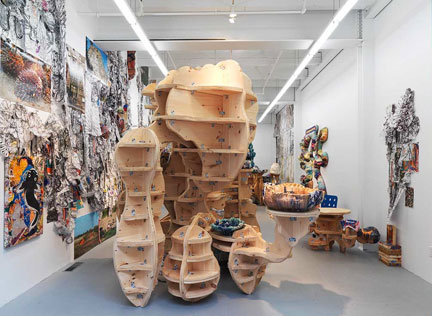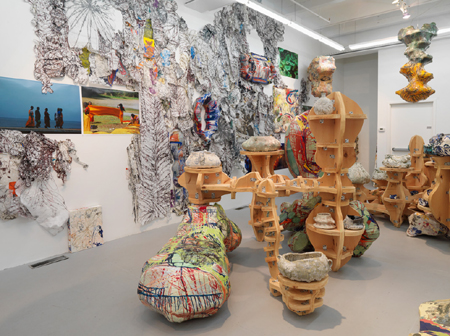IMAGES: MARK COOPER Google Images
WEBSITE: MARK F COOPER
CONTACT: 617-832-5976 mfcooper@earthlink.net
LINKS: Samson Gallery, Boston
BIO/CV: Mark Cooper’s paintings and sculptures made with fiberglass pieces, layered with rice paper, paint, silk-screens, and varying images and patterns, explore dualities of culture and meaning. Cooper is best-known for his large public art pieces, made in collaboration with children, hospital patients, students, and other constituencies, for such institutions as The Museum of Fine Arts Boston, Boston College Museum, Capital Children’s Museum in Washington, DC, DeCordova Museum and Sculpture Grounds, and the Whitney Museum of American Art at Philip Morris.
He received his MFA from Tufts University/SMFA, and is currently an Adjunct Professor at Boston College, as well as a Graduate and Regular Faculty at the SMFA. Cooper’s work is in several major museums, as well as corporate and private collections.
BIBLIOGRAPHY:
- Review in Art in America Jan 2012
- MARK COOPER — SAMSØN PROJECTS
In his recent show “More is More,” multi medium artist Mark Cooper crammed over 2,200 individual works, made between 2005 and 2011, into Samsøn’s long, narrow gallery. As a professor at Boston College and the School of the Museum of Fine Arts, Cooper has long been an influential presence in this city. He’s best known for his biomorphic fiberglass sculptures – large, crude, colorful – several of which were displayed on walls or the floor, or hung from the ceiling. He is also a skilled ceramist, photographer and painter.
All Cooper’s mediums were represented in the souk like installation of this show. Cascades of over 2,000 overlapping rice-paper cutouts featuring line drawings of organic shapes fluttered gracefully on the walls, Created with black etching ink on white paper and ranging from palm-size to long and frond like. They formed a soft backdrop for the other work.
Nearly 50 small vibrant gestural paintings on wood panel were casually stacked here and there into columns, but the floor was dominated by tall, raw wood structures – curving, multistrutted shapes with hardware joinery in full view. Resembling outsize furniture designed by Dr. Seuss.
the pieces are based on the infrastructure of Cooper’s biomorphic sculptures. During a conversation in the gallery he told me how, while tinkering with the latter pieces, he became intrigued by their bare frame work. Here, he uses the exposed struts as shelves to display his quasi-functional ceramics, Though crafted like venerable majolica and celadon, these vessels flout finesse. Ranging from hand to tabletop size, they are displayed just as they come from the kiln, all imperfections welcome. Squashed, lumpy, sagging, cracked, with glaze flaking off in large chunks, they were the most appealing objects here. The gourd like celadon pieces are especially primitive. The newer majolica works come closer to conventional ceramics. Jacks Are Wild #11 (2011), a blue and white vase, has multiple handles, like ribbon candy, marching up its sides and would make a wacky umbrella stand. In this piece and others, Cooper parodies sedate ceramic tradition by slapping on decorative glaze in his trademark expressionistic style of wild loops and circles.
Clues to Cooper’s influences can be found in photographs taken in India.
These were tucked among the paintings and drawings on the gallery walls. Showing burlap and bamboo scaffolding, Sacred banyan trees hung with fertility offerings, and village women in brilliantly red saris, they bring context to Cooper’s own generous freewheeling color-doused esthetic.
-Ann Wilson Lloyd
- Review in Boston Globe Jan 2012
- Clamorously Creative, It’s Art Gone Wild
- Mark Cooper’s hot-hued collages overlap in a riot of images
- by Cate McQuaid, Globe Correspondent
“More Is More” Is an apt title for Mark Cooper’s daringly gluttonous exhibit at Samson. Cooper has plastered the walls with his prints, photographs, and paintings. His ceramic vessels squat on top of his sculptures. Undulant wooden forms with shelves might be taken as pedestals until you see that they too, in places, sit atop other sculptures. The gallery is so crowded with art that you have to be careful where you step.
Cooper effectively disrupts expectations about the relationship between viewer and art. It’s no longer a one-on-one relationship between person and object. Nor is it a singular installation piece. It’s a riot in which the art encroaches on you, very nearly breathing down your neck. It almost makes the viewer unnecessary — as if the art were having a jolly enough party on its own, thank you very much.
But stay, because it is a rollicking good time. Cooper shuffles several basic structures. He has loopy, bulbous sculptures such as “Jacks Are Blue”, which looks something like a 12-headed beast with three legs, streaked with royal blue and periwinkle. His delicate silkscreen images on rice paper look like dragonfly wings, overlapping with hot-hued photographs of India. His collaged, multileveled paintings, such as “After India #28” race with images, centipede-like drips and patches of color, all finished off with glossy surfboard resin. The whole thing is a clamorous collage in three dimensions.
Ceramic vessels adorn sculptures as jewels highlight a beautiful face. Some are blue and white, recalling Delft porcelain. Some reference ancient Chinese bronzes. Some crackle as if about to shed their skins. Despite their evident lineage, they are lumpy, humble things. Cooper abhors hierarchy. Even the most beautiful lines and shapes here have rugged qualities. “More is More” elevates nothing – except the act of creation – sifting through history and across cultures to make a spicy, messy, tasty stew of a show.
ARTIST STATEMENT — Northern Ireland Project – Tearing Down Walls
There is a tremendous power and impact in experiential learning. Through the transparent act of discussing, debating, and coming up with an agreed approach to their painted contributions the young people involved in this project have made a public statement about the desire to break down walls and barriers that have existed for a very long time. Like a bundle of sticks that is far stronger than the individual sticks, their combined efforts make for a powerful statement on reconciliation. Having had the opportunity to discuss the types of walls we build in our minds, that we inherit from our parents and peers, and that, although invisible, are very much present, participants then came up with agreed upon ways to visually represent taking down these walls. This is an experience they will never forget. It also impacts their family, friends, and community.
There are powerful additional benefits from the collaborative project. Placing the finished artwork in a public place of respect is empowering to the individual participants as well as the group. Each participant feels ownership through the process of conceptualizing and actualizing their efforts. Succeeding in this effort is a roadmap to their succeeding in the future in any number of endeavors specific to their interests like career choices or ways to benefit from working together. This collaborative effort is a combination of the best of all worlds: a powerful visual statement generated from the conversation between individual contributors irrelevant of style or skill, driven by the urgent idea of reconciliation and tearing down walls.





